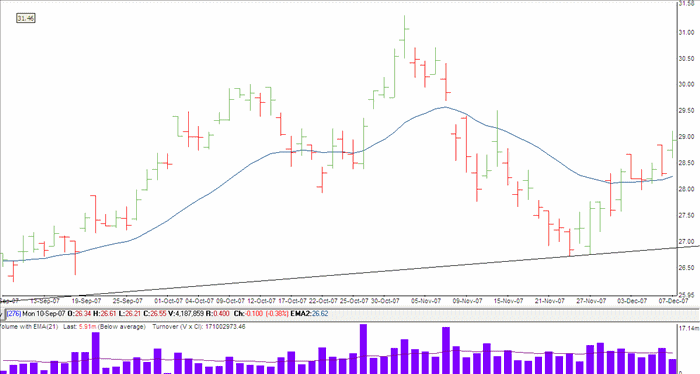
End of Week 4
The stock opened higher on Monday then retreated to the M/A. It then more or less travelled along the M/A line, as you can see, before moving higher on Friday and closing at $28.92 for the week. This puts us in profit by around ($28.92 - $28.30 times 1000) $600, which is not bad for the first month of business. The question that you may be asking now is, "How do we know when to sell?".

The Trailing Stop
While many and varied, there are methods we can use to manage our trade. Some traders like to set a profit target, such as $1000. For this trade, I'm using a different method, the "trailing stop".
This means that when I opened the trade at $28.30, I set a pre-determined maximum amount I was prepared to lose if the trade were to go against me. For this particular trade, I made it $800. So, I set my stop at 80 cents below the purchase price. This gives the stock a decent amount of breathing space if it retraces slightly.

So, if the stock were to drop to my stop at $27.50, I'd sell and take the loss. Admittedly, in real life I wouldn't do this, but I'm merely demonstrating some technical tools.
The stop covers the downside if the trade goes bad, but what if the stock goes up as it did? Well, this is where the stop-loss becomes what is known as a "trailing" stop. Each day at close, the stop is adjusted according to the closing price. If the stock closed 65 cents higher than yesterday, the stop is moved up 65 cents, maintaining that 80 cent gap. It is never moved down, only up. In this way, it "trails" the stock and is used to lock in profits.
At the end of yesterday's trade, I moved the stop up to $28.12 as the stock closed at $28.92, but what I also did was tighten the stop by 30 cents to eliminate all risk. We seem to have gotten our timing and direction right, so we can adjust our stop to suit. The stop is now at $28.42, meaning the trade will be profitable no matter what as it is above the purchase price of $28.32. I did this because the price went up and I'm not worried about it going bad anymore, but rather I'm now more interested in locking in profits. Each time the stock closes above the previous day's close, the stop gets moved up to 50 cents below it instead of 80.
You could think of the trailing stop as someone climbing a building using a painter's platform as a safety precaution. The platform is 5 metres below him and as he climbs, the platform moves higher in case he falls at some stage. It is always 5 metres away, but if he falls, it does not go down. Instead, he lands safely without too much damage.
Options Explained - Click Here
The stop is placed online or with your broker over the phone. It consists of a trigger price and a minimum sell price. These are entered at the time of setting up the stop and can be done after hours. The diagram below explains.

Week 5

|